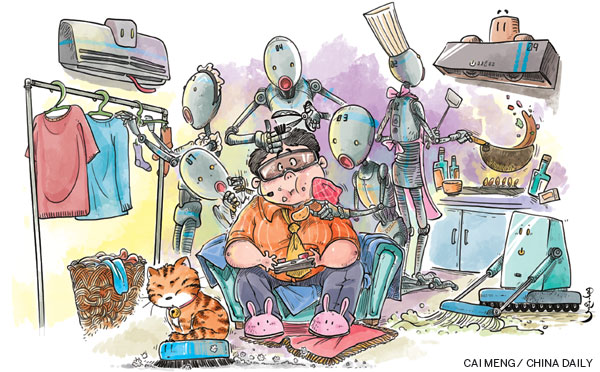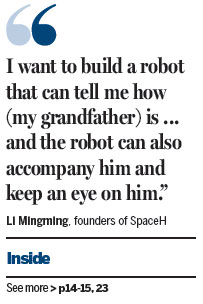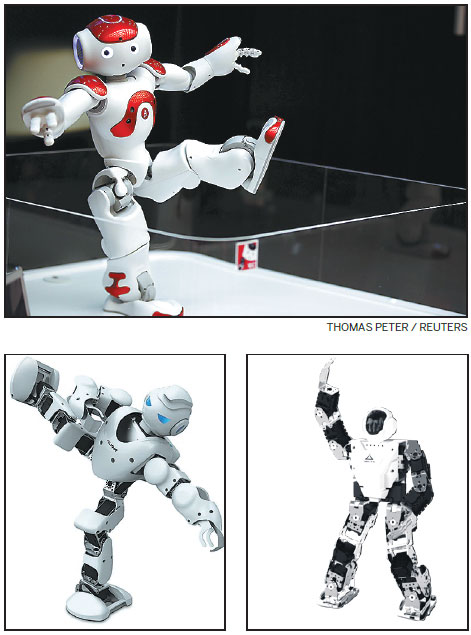Almost human
Robots are set to become a bigger part of everyday life, as they develop from being machines on a production line to tools to help care for children and the elderly. China is at the cutting edge of this brave new world, Yang Yang reports
When Li Mingming and Gong Meng, founders of SpaceH, decided to build a robot in Oct 2013, they wanted to do something to help their families.
The two young men were working in Shenzhen, thousands of kilometers away from their hometowns. Li wanted to keep up to date with his grandfather, who, in his 80s, was living in Nanchang, Jiangxi province.

"My grandfather is not well and we hire a nurse to look after him for eight hours a day. I am so far away from him and I want to keep updated about his latest situation, but he cannot even use the phone. So I want to build a robot that can tell me how he is and can let me see and talk to him when I want," Li, 30, says, "and the robot can also accompany him and keep an eye on him."
Gong also wanted his parents in Shandong province who suffer from chronic diseases, to have a companion at home, to supervise them to take medicines on time and to complete regular self-examinations.
In the 2014 animation film Big Hero 6, the white inflatable robot Baymax impressed audiences with its cute huggable look and ability to scan people's bodies to get their physical and psychological status and then give useful advice.
At the end of 2014, SpaceH built its first robot named Xiaohei, (little black), a play on Dabai (big white), Baymax's Chinese name.
Xiaohei can recognize its surroundings, and use sign language and follow simple oral orders, such as "come" and "go". Keeping its distance, it can follow the "nursing object" and bypass the objects in its way.
"The initial Xiaohei is designed for children, partly for entertainment and partly for remote nursing. The upgraded edition will be more suitable for elderly people and people with chronic diseases," Li says, "In addition to the robotic terminal, we will a build a cloud service platform for remote nursing and medical treatment."
With Chinese society getting older, more nursing services are needed, especially when many families have only children who leave their parents to live in major cities.
As the factory of the world, China has seen the development of its manufacturing reach a stage where development and wide use of automation technology is critical to future development.
Zhu Shiqiang, director of Robotics Research Center at Zhejiang University, says the market value of robots in China will reach 100 billion yuan in the future.
With such a large market potential, robot companies are springing up like bamboo shoots in spring. SpaceH is one of 400 companies that registered in 2014, but globally there are fewer than 10 major robot companies.
Since 2013, China has become the world's largest robot market. However, about 75 percent of the domestic market share is taken up by international giants: ABB, Fanuc, Yaskawa and Kaku.

Experts say that to compete with these industrial leaders, Chinese companies should pay more attention to innovation and diversified competition.
In terms of robotic science and technology, China has made progress in many areas.
In July 2014, the robot team from Zhejiang University beat Carnegie Mellon University at the Federation of International Robot-soccer Association Cup, and defended the championship.
In December 2013, China sent Jade Rabbit Rover to the moon. The rover can observe the surrounding environment on the moon and plan its roaming route, and can turn away from slopes above 20 degrees, rocks taller than 20 centimeters and impact craters bigger than 2 meters in diameter. To better work on the moon, Jade Rabbit went into hibernation every 14 days due to the huge temperature difference between day and night. Jade Rabbit would wake up automatically, but broke down once during the mission.
"Our robotic technology indeed has reached advanced international levels in some aspects, but generally speaking we are lagging behind," says Wang Shuo, researcher at Institute of Automation, China Academy of Sciences.
Zhu Shiqiang says China's robot manufacturers have yet to master the skill of producing the core parts of industrial robots, such as joint reducers and sensors.
"Even if we can produce industrial robots on our own, their reliability is not as good as those by international leading companies," Zhu says.
Zhu says if China wants to develop robotics as an industry, more attention must be paid to the research and development of products, such as technology and practicality and not only pure scientific research.
Wang and Zhu emphasize the importance of exploring new routes for global competition and the research and development of products.
Wang says the big four robot companies dominate the auto industry, so domestic companies can look for opportunities in other industries.
For Zhu, Chinese researchers should stop following others. "We should try to find new routes. For example, if we cannot produce good-quality joint reducers in a short time, maybe we should try to create some new ways to replace them."
In the international arena, some Chinese companies have done very well through innovation.
Registered in 2000, Siasun Robot and Automation has grown to be the top domestic robot enterprise. Its market value is estimated to reach 35 billion yuan, the largest of its kind in China and the third-largest in the world. Two-thirds of its products are used by foreign-owned companies. The products are exported to 15 countries around the world.
Its new robot for automated guided vehicles has been applied in the assemblies of leading auto companies like Ford. They have also been exported to Europe in large quantities.
For Qu Daokui, vice board chairman and chief executive officer of Siasun, the most important drive for the fast growth of the company is innovation.
"Robots are a rapidly developing high-tech product. Its technological lifecycle is very short. The international competition of robots relies greatly on innovation," Qu said.
Every year, Siasun invests more than 12 percent of its revenue into research and development.
About 80 percent of employees in Siasun are working in research and development. In its 20,000 square-meter factory, one can seldom see workers. Robotic arms are busy installing robot parts and AGV robots complete the transportation.
In April, Siasun was chosen by the government to join the list of the 10 most famous Chinese brands, alongside Huawei, Haier and China South Locomotive.
Now a research and development team in Siasun, led by Senior Engineer Zou Fengshan, is working hard to develop compound robots that will combine robotic arms, feet and eyes into one robot and coordinate them to work.
"This is the cutting-edge robot that all robot giants are trying to build," Zou says.
"We are confident that we will be able to conquer all the difficulties this year," Qu says.
Industrial robots are key to China's manufacturing and the market is growing quickly. However, in 2017, the market value of service robots in China will surpass that of industrial robots, says Zhu Shiqiang.
Li Mingming and Gong Meng's SpaceH are among the companies trying to build robots that can provide services.
Zhou Jian, 39, CEO of Ubtech, became interested in humanoid robots in 2008. Since then, he has poured all of his 50-million-yuan savings into the research and development of humanoid robots.
In August 2013, the first robot product Alpha entered the market at a price of 6,600 yuan, which is much cheaper than Nao (150,000 yuan) developed by Aldebaran Robotics.
But Alpha is very popular. Orders in the first part of 2015 have reached 100 million yuan, which is what Zhou had expected to sell during the course of the entire year.
More than 30,000 Alpha robots have now sold. Zhou estimates that revenue for 2015 will surpass 200 million yuan, and in 2016 it is expected to surpass 1 billion yuan, with 50 to 60 percent of the orders coming from overseas.
When Zhou first tried to find a way to build a humanoid robot for middle-class consumption, he found two key factors that affected the popularity of humanoid robots such as Nao.
"There are two bottlenecks for commercial intelligent humanoid robots. One is the high cost of component parts, the other is the difficulty in programming," he said.
A robot shorter than half a meter will cost tens of thousands of yuan to produce, not to mention how high the retail price will be. Besides, most humanoid robots do not allow users to program them.
"I thought at that time, if I can conquer these two bottlenecks, the market will be huge for me," he said.
It was not easy. Zhou spent all his money and his family and friends refused to lend him any more. But Zhou and his team successfully developed their own core component part: the Servo, the cost of which is only one-tenth of that of Japanese robots.
Zhou further lowered the cost by using cheaper chips that are good enough to guarantee quality. And Ubtech created a programming software that allows even middle school students to create their own movement orders.
Once he had figured out those two issues, Ubtech grew quickly.
Ubtech now is worth $200 million, and soon the second generation of Alpha will be released.
The first generation can move, walk, sing and dance, and the second generation can talk with people. Meanwhile, the company is developing a 160-centimeter tall robot that can talk and play chess with people.
"It will feel just like a real person," Zhou said.
Like Siasun, Ubtech also focuses on research and development. About 70 percent of the company's employees are on the R&D team, including talents from Massachusetts Institute of Technology and Tsinghua University.
Statistics from the International Federation of Robotics shows that China's demand for industrial robots is growing at a speed of above 25 percent per year.
According to McKinsey, by 2025, advanced robots will generate $1.7 trillion to $4.5 trillion in fields including manufacturing, medicine and services.
Qu says the government should support private enterprises in developing the robotics industry. "I think our government should build an open platform to use talent, capital and other resources not only from home but also from abroad. Then we can grow up in a short time just like E-business in China" Qu says.
"The robotics industry is important for almost every developed country. They have all decided to develop robotics as a national strategy. It is a comprehensive technology that will promote the development of many relevant technologies such as materials, big data, sensor technology and so on. It's key to the future of our manufacturing industries," Qu says, "and it will also be very crucial for future civil life and military affairs".
"Robotics is a good development opportunity for China. We should make good use of it," he says.
Contact the writer at yangyangs@chinadaily.com.cn
|
Aldebaran Robotics' Nao, top, retails for 150,000 yuan, much more than Ubtech's Alpha, left, which entered the market at a price of 6,600 yuan. Ubtech also produces the Delta (right). Provided to China Daily |
(China Daily 04/25/2015 page13)















